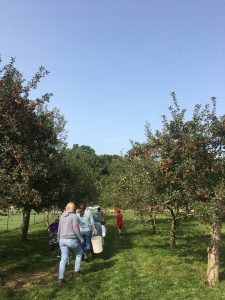For the first week of my internship I visited Stratford Ecological Center to observe the Wednesday morning Farm School program. The Farm School Program is a new program at Stratford, and it was developed to accommodate the COVID-19 pandemic and current restrictions. Farm School is solely an outdoor, full-day program for grade-level students that focuses on helping children learn from and experience nature. April Hoy, the lead environmental educator at Stratford, led the program which focused on learning about the basic jobs and tasks of working on the farm as well as tending gardens and exploring native habitats. The program began by discussing the biotic and abiotic factors of a farm ecosystem and how they are important to one another. After learning about the ecosystem, we examined the animals on the farm and checked off daily farm tasks that ensure the needs of the animals are being met. The morning portion of Farm School touched on other topics as well, like what native pollinators are and how we can support them.

Photo taken during Farm School Program in the orchard going to feed baby goats at Stratford Ecological Center.
This past week, April and I discussed further details for my final project. My initial project focus was too broad in focus and the primary purpose of our meeting this week was to narrow my focus to something more specific and manageable for the amount of time I will be on campus this semester. As a result, my condensed project focus is to develop hands-on outdoor continuation activities that children can do at home. These activities will be related to topics mentioned during Farm School or at similar programs and these activities will provide additional hands-on learning opportunities for children after the time of the program. The idea behind this project was also to find more ways in which Stratford can continue their mission during the unprecedented times of the pandemic. The activity topics I will be focusing on are backyard habitats for native pollinators and a solar-related activity. These topics are things April already touches on during her program but not topics that she has the opportunity to cover in-depth. These activities will also try to cover a deeper STEM-based curriculum as this is an ongoing goal for environmental education at Stratford.


